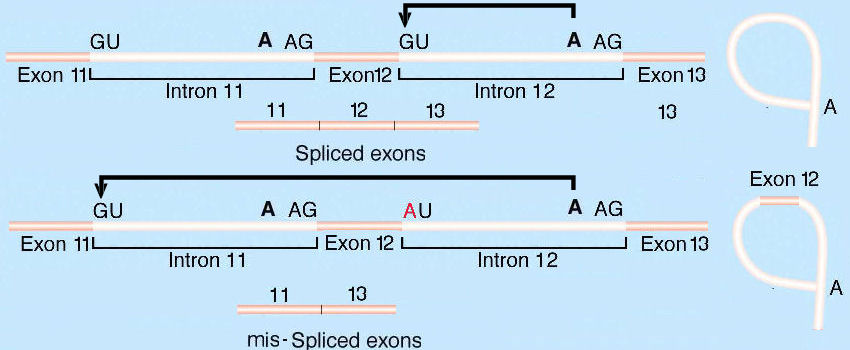The most prevalent allele identified in persons
of European descent with the
metabolic disease Phenylketonuria (PKU) is a single-base SNP (GT-to-AT in the DNA
sense strand) that corresponds to a change from 5'-GU to 5'-AU in the
mRNA for the splice donor site of Intron
12, as shown in the second
diagram above. This makes the site unrecognizable by the splicing
enzymes. During intron removal, the A site in Intron
12 bypasses the
altered site in the 5' 3'
direction (here, right to left), attaches incorrectly to the
5'-GU site of Intron 11. This excises Exon
12 along with Introns
11 & 12.
Analysis of cDNA clones
confirms that individuals with this SNP have the expected
156bp deletion in the mRNA,
corresponding precisely to the length of Exon 12.
The truncated PAH protein
lacks
156 bp / 3 = 52 amino acids
at the C-terminus, as
predicted. This result is an unstable protein with almost zero PAH activity.
3'
direction (here, right to left), attaches incorrectly to the
5'-GU site of Intron 11. This excises Exon
12 along with Introns
11 & 12.
Analysis of cDNA clones
confirms that individuals with this SNP have the expected
156bp deletion in the mRNA,
corresponding precisely to the length of Exon 12.
The truncated PAH protein
lacks
156 bp / 3 = 52 amino acids
at the C-terminus, as
predicted. This result is an unstable protein with almost zero PAH activity.
Note on terminology: exon and
intron properly refer to regions of the DNA, which
when transcribed as RNA, are respectively expressed
and
intervening. Corresponding regions in the RNA should
properly be referred to as exon & intron equivalents.
Textbooks are inconsistent, as here. The important point in this
example is that the altered PAH protein originates from a
single-base pair mutation (SNP) in the DNA,
rather than deletion of Exon 12 as a length "mutation"
in mRNA.

